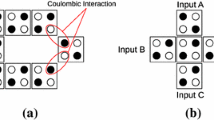Abstract
The class of quasi-delay-insensitive (QDI) asynchronous circuits provides a promising approach toward tolerating process variations. However, the fundamental assumption of QDI circuits is that some wires in such circuits are isochronic; this assumption is more and more challenged by the shrinking technology. This paper redresses the weakest fork timing constraints for QDI asynchronous pipelines to work correctly under arbitrary wire and gate delay variability. We model a QDI circuit using the signal transition graph and propose a method to detect isochronic fork candidates. Extensive analysis is exploited to justify the necessary and sufficient isochronic fork selections of a QDI template. The proposed method works for many QDI templates, and it provides some necessary information about the constraint on any wire fork required for an asynchronous EDA tool in nanotechnology era. Experimental results demonstrate that the proposed method results in more robust QDI circuits in the expense of the least design overheads comparing to the similar method suggested in the current literature.








Similar content being viewed by others
References
Borkar S, Karnik T, Narendra S, Tschanz J, Keshavarzi A, De V (2003) Parameter Variations and Impact on Circuits and Micro-architecture. In: Proceedings of DAC, pp 338–342
Kiamehr S et al (2016) The Impact of Process Variation and Stochastic Aging in Nanoscale VLSI. In: 2016 IEEE International Reliability Physics Symposium (IRPS), Pasadena, CA, USA, pp CR-1-1–CR-1-6
Tang CK, Lin CY, Lu YC (2008) An Asynchronous Circuit Design with Fast Forwarding Technique at Advanced Technology Node. In: Proceedings of ISQED, pp 367 – 372
Beerel Peter A (2002) Asynchronous Circuits: An Increasingly Practical Design Solution. In: Proceedings of ISQED, pp 769–773
Nowick SM, Singh M (2015) Asynchronous design—part 1: overview and recent advances. IEEE Design Test 32(3):5–18
Nowick SM, Singh M (2015) Asynchronous design—part 2: systems and methodologies. IEEE Design Test 32(3):19–28
Brzozowski JA, Seger C-JH (2012) Asynchronous circuits. Springer Science and Business Media, Berlin
Martin Alain J (1990) The Limitations to Delay Insensitivity in Asynchronous Circuits. In: Proceedings of MIT Conference on Advanced Research in VLSI Processes, pp 263–277
Lines Andrew M (1995) Pipelined asynchronous circuits. Master’s thesis, California Institute of Technology, Computer Science Department, 1995. CS-TR-95-21
Martin AJ (1986) Compiling communicating processes into delay-insensitive VLSI circuits. Distrib Comput 1(4):226–234
Rahbaran B, Steininger A (2009) Is asynchronous logic more robust than synchronous logic? IEEE Trans Dependable Secure Comput 6(4):282–294
Stevens KS, Golani P, Beerel PA (2010) Energy and performance models for synchronous and asynchronous communication. IEEE Trans Very Large Scale Integr VLSI Syst 19(3):369–382
Imai M, Komaba TN (2008) Performance Comparison between Self-timed Circuits and Synchronous Circuits Based on the Technology Roadmap of Semiconductors. In: IEEE/IFIP DSN, 2nd Workshop on Dependable and Secure Nanocomputing, p 37
Broughton R, Yelleswarapu R, Di J, Mantooth HA (2006) Supply Voltage Scalability Comparison of Synchronous and Asynchronous Digital Circuits under Low Temperature to Examine Suitability for Space Applications. In: Seventh International Workshop on Low Temperature Electronics, p 67
Saifhashemi A, Huang HH, Beerel PA (2017) Reconditioning: a framework for automatic power optimization of QDI circuits. IEEE Trans Comput Aided Design Integr Circuits Syst PP(99):1–1
Keller S, Katelman M, Martin AJ (2009) A Necessary and Sufficient Timing Assumption for Speed-Independent Circuits. In: Proceedings of ASYNC, pp 65–76
Sparso J, Furber S (2002) Principles of asynchronous circuit design—a system perspective. Kluwer Academic Publishers, Dordrecht
Martin AJ, Lines A, Manohar R, Nystroem M, Penzes P, Southworth R, Cummings U, Lee TK (1997) The Design of an Asynchronous MIPS R3000 Microprocessor. In: Proceedings of Conference on Advanced Research in VLSI, pp 164–181
Ozdag Recep O, Beerel Peter A (2002) High-Speed QDI Asynchronous Pipelines. In: Proceedings of ASYNC, pp 13–22
Couvreur CY, Lin B, Goossens G, Man HD (1993) Synthesis and Optimization of Asynchronous Controllers Based on Extended Lock Graph Theory. In: Proceedings of European Conference on Design Automation, pp 512–517
ITRS (2009) International technology roadmap for semiconductors, http://public.itrs.net
Stevens K, Ginosar R, Rotem S (2003) Relative timing (asynchronous design). IEEE Trans Very Large Scale Integr VLSI Syst 11(1):129–140
van Berkel K (1992) Beware the isochronic fork. Integr VLSI J 13(2):103–128
Fant K (2005) Logically determined design. Wiley, Hoboken
Sretasereekul N, Nanya T (2001) Eliminating Isochronic Fork Constraints in Quasi-Delay-Insensitive Circuits. In: Proceedings of ASP-DAC, pp 437–442
Beerel PA, Burch JR, Meng TH (1994) Sufficient Conditions for Correct Gate-Level Speed-Independent Circuits. In: Proceedings of ASYNC, pp 33–43
Yakovlev A, Kishinevsky M, Kondratyev A, Lavagno L, Pietkiewicz-Koutny M (1996) On the models for asynchronous circuit behaviour with OR causality. Form Methods Syst Des 9(3):189–233
Lavagno L, Keutzer K, Sangiovanni-Vincentelli A (1991) Algorithms for Synthesis of Hazard-Free Asynchronous Circuits. In: Proceedings of DAC, pp 417–421
Beerel PA, Ozdag RO, Ferretti M (2010) A designer’s guide to asynchronous VLSI. Cambridge University Press, Cambridge
Ghavami B, Pedram H, Najibi M (2009) An EDA tool for implementation of low power and secure crypto-chips. Comput Electr Eng 35(2):244–257
Raji M, Ghavami B, Zarandi HR, Pedram H (2011) Assessment of Nano-scale Asynchronous PCFB Circuits Under Extreme Process Variation. In: 2011 3rd Asia Symposium on Quality Electronic Design (ASQED), pp 134–139
Author information
Authors and Affiliations
Corresponding author
Rights and permissions
About this article
Cite this article
Raji, M., Ghavami, B. Redressing fork constraints in nanoscale quasi-delay-insensitive asynchronous pipelines. J Supercomput 74, 3820–3840 (2018). https://doi.org/10.1007/s11227-017-2056-0
Published:
Issue Date:
DOI: https://doi.org/10.1007/s11227-017-2056-0




